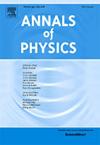被弦流体包围的海沃德- ads黑洞的焦耳-汤姆逊膨胀
IF 3
3区 物理与天体物理
Q2 PHYSICS, MULTIDISCIPLINARY
引用次数: 0
摘要
在这项工作中,我们研究了被弦流体包围的常规海沃德- ads黑洞的焦耳-汤姆逊膨胀。我们分析了焦耳-汤姆森系数μJ、反演温度Ti和等焓曲线的行为,以了解Hayward参数Θ和管柱流体参数b、β等关键参数对黑洞热力学的影响。我们的研究结果表明,管柱流体的存在显著地改变了黑洞的冷却-加热转变,改变了反转曲线,改变了相变结构。β值越高,反演温度越高,说明弦流体参数增强了黑洞的冷却能力。同样,Θ和b的变化也会影响反转压力和温度,这表明量子引力启发的修正引入了标准AdS黑洞所没有的新热力学性质。T - P平面的图形分析进一步说明了等焓曲线的偏差,证明了质量和外部弦相互作用对黑洞热力学的影响。这些发现为常规黑洞的热力学行为及其与量子引力的可能联系提供了更深入的见解。我们的研究有助于更广泛地理解修正重力情景下的黑洞相变。它提出了未来研究熵修正和这些修正的热力学行为的观测意义的潜在途径。本文章由计算机程序翻译,如有差异,请以英文原文为准。
Joule–Thomson expansion of Hayward-AdS black hole surrounded by fluid of strings
In this work, we investigate the Joule–Thomson expansion of a regular Hayward-AdS black hole surrounded by a fluid of strings. We analyze the behavior of the Joule–Thomson coefficient , the inversion temperature , and isenthalpic curves to understand the impact of key parameters such as the Hayward parameter and the fluid of string parameters on black hole thermodynamics. Our results reveal that the presence of the string fluid significantly modifies the black hole’s cooling-heating transition, shifting the inversion curves and altering the phase transition structure. The inversion temperature increases with higher values of , indicating that the fluid of strings parameter enhances the cooling capacity of the black hole. Similarly, variations in and affect the inversion pressure and temperature, showing that quantum gravity-inspired modifications introduce new thermodynamic properties absent in standard AdS black holes. The graphical analysis of the plane further illustrates the deviations in isenthalpic curves, demonstrating the influence of mass and external string interactions on black hole thermodynamics. These findings provide deeper insights into the thermodynamic behavior of regular black holes and their possible connections to quantum gravity. Our study contributes to the broader understanding of black hole phase transitions in modified gravity scenarios. It suggests potential avenues for future research on entropy corrections and the observational implications of these modified thermodynamic behaviors.
求助全文
通过发布文献求助,成功后即可免费获取论文全文。
去求助
来源期刊

Annals of Physics
物理-物理:综合
CiteScore
5.30
自引率
3.30%
发文量
211
审稿时长
47 days
期刊介绍:
Annals of Physics presents original work in all areas of basic theoretic physics research. Ideas are developed and fully explored, and thorough treatment is given to first principles and ultimate applications. Annals of Physics emphasizes clarity and intelligibility in the articles it publishes, thus making them as accessible as possible. Readers familiar with recent developments in the field are provided with sufficient detail and background to follow the arguments and understand their significance.
The Editors of the journal cover all fields of theoretical physics. Articles published in the journal are typically longer than 20 pages.
 求助内容:
求助内容: 应助结果提醒方式:
应助结果提醒方式:


